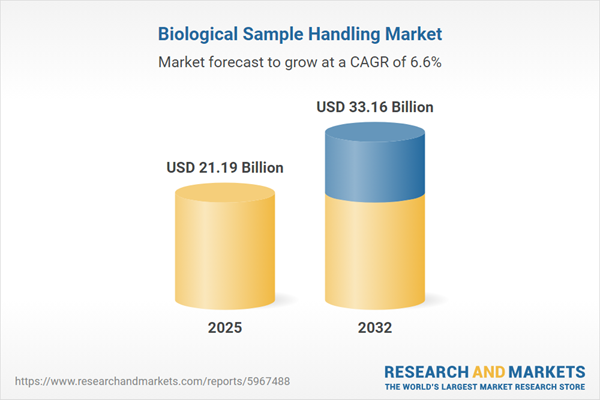Speak directly to the analyst to clarify any post sales queries you may have.
The biological sample handling market plays a pivotal role in supporting precision, compliance, and operational continuity across life sciences and healthcare. As the value of specimen integrity grows, advanced specimen management is fundamental for organizations aiming to enhance research accuracy and patient outcomes worldwide.
Market Snapshot: Biological Sample Handling Market
The Biological Sample Handling Market grew from USD 19.85 billion in 2024 to USD 21.19 billion in 2025. It is expected to continue growing at a CAGR of 6.62%, reaching USD 33.16 billion by 2032.
Growth is driven by an expanding scope of diagnostic applications, tighter regulatory oversight, and rapid technological innovation throughout research and clinical laboratory environments. Escalating demand for integrated solutions across the handling ecosystem is catalyzing investment in automation, informatics, and sustainability-focused processes.
Scope & Segmentation: Biological Sample Handling Market Analysis
- Product Types: Consumables, automated pipetting systems, temperature controlled centrifuges, vortex mixers, reagents and kits (e.g., antibodies, buffers and solutions, enzymes, labeling and detection reagents), as well as software and services.
- End Users: Academic and research institutes, biopharmaceutical companies, contract research organizations, diagnostic laboratories (including clinical chemistry, hematology, microbiology, molecular diagnostics), and hospitals.
- Applications: Diagnostics, laboratory diagnostics, point of care, drug discovery and development, genomics, and proteomics.
- Sample Types: Blood, cells, tissue, urine.
- Workflow Stages: Analysis, collection, processing, storage, transport.
- Geographic Segments: Americas (USA, Canada, Mexico, Brazil, Argentina, Chile, Colombia, Peru), Europe Middle East & Africa (including the UK, Germany, France, Russia, Italy, Spain, Netherlands, Sweden, Poland, Switzerland, UAE, Saudi Arabia, Qatar, Turkey, Israel, South Africa, Nigeria, Egypt, Kenya), Asia-Pacific (China, India, Japan, Australia, South Korea, Indonesia, Thailand, Malaysia, Singapore, Taiwan).
- Leading Companies: Thermo Fisher Scientific Inc., Danaher Corporation, Merck KGaA, Agilent Technologies, Avantor, Bio-Rad Laboratories, PerkinElmer, Sartorius, QIAGEN, General Electric Company.
Key Takeaways for Senior Decision-Makers
- Strategic specimen management is foundational for research accuracy, operational continuity, and compliance across life sciences organizations.
- Automated systems, artificial intelligence, and advanced digital monitoring are transforming sample handling, driving both efficiency and traceability.
- Stakeholders must balance operational needs with the growing sustainability requirements by adopting eco-friendly consumables and energy-efficient storage solutions.
- Regional market growth is shaped by varying drivers: established regulatory frameworks and innovation hubs in the Americas, harmonization and investment programs across EMEA, and infrastructure upgrades and R&D growth spurring adoption in Asia-Pacific.
- Cross-functional collaborations, such as partnerships between equipment manufacturers and reagent suppliers, now accelerate solution compatibility and workflow optimization.
Impact of 2025 United States Tariff Changes
Revised tariffs in 2025 have altered sourcing and procurement strategies for U.S. stakeholders. Elevated duties on imported reagents, consumables, and instruments have led to new supply chain partnerships—emphasizing regional distribution, alliances with domestic producers, and strategic inventory activities. As a result, organizations increasingly prioritize supply chain transparency, compliance, and operational resilience in response to evolving trade landscapes.
Methodology & Data Sources
This report integrates primary interviews with laboratory and procurement leaders, alongside secondary data from regulatory literature and scientific publications. Market trends and projections are validated through financial data triangulation, proprietary shipment records, and scenario modeling to ensure a robust market view encompassing both operational and strategic insights.
Why This Report Matters
- Enables precise alignment of product and service portfolios with emerging laboratory and diagnostic demands across global regions.
- Supports informed, strategic investment decisions by highlighting technology trends, compliance shifts, and supply chain realignments.
- Equips C-suite executives with actionable competitive intelligence, enhancing agility in market entry, expansion, and risk mitigation initiatives.
Conclusion
Senior leaders face an evolving landscape where agility, integration, and sustainability will determine future success. Leveraging actionable insights from this report empowers organizations to optimize sample handling strategies and accelerate growth opportunities across global life science and healthcare markets.
Additional Product Information:
- Purchase of this report includes 1 year online access with quarterly updates.
- This report can be updated on request. Please contact our Customer Experience team using the Ask a Question widget on our website.
Table of Contents
3. Executive Summary
4. Market Overview
7. Cumulative Impact of Artificial Intelligence 2025
Companies Mentioned
The companies profiled in this Biological Sample Handling market report include:- Thermo Fisher Scientific Inc.
- Danaher Corporation
- Merck KGaA
- Agilent Technologies, Inc.
- Avantor, Inc.
- Bio-Rad Laboratories, Inc.
- PerkinElmer, Inc.
- Sartorius AG
- QIAGEN N.V.
- General Electric Company
Table Information
| Report Attribute | Details |
|---|---|
| No. of Pages | 188 |
| Published | October 2025 |
| Forecast Period | 2025 - 2032 |
| Estimated Market Value ( USD | $ 21.19 Billion |
| Forecasted Market Value ( USD | $ 33.16 Billion |
| Compound Annual Growth Rate | 6.6% |
| Regions Covered | Global |
| No. of Companies Mentioned | 11 |









